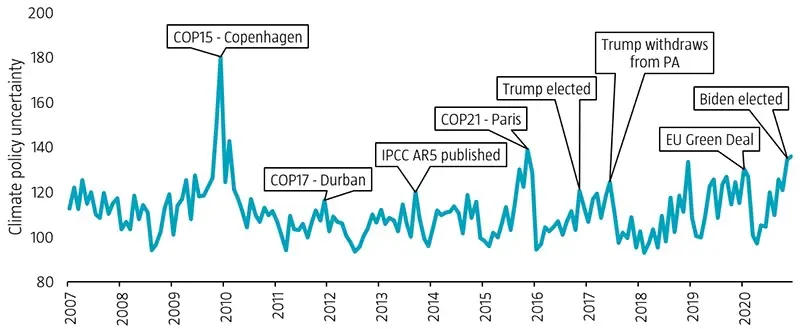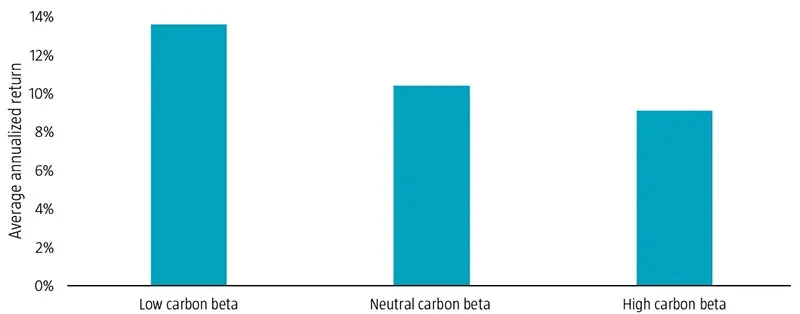Dries, can you briefly tell us about yourself and the innovative research project you were involved in?
Dries Laurs: “Sure. As a member of the Robeco PhD program, I’m a researcher in the Sustainable Index Solutions team and a PhD candidate at Vrije Universiteit Amsterdam. For my PhD research, I’m focusing on how climate change affects financial markets and how investors can deal with this issue. In line with this, I recently co-authored my first paper1 with two professors from the university, Philip Stork and Remco Zwinkels, as well as Joop Huij, who is one of my PhD supervisors and Head of Sustainable Index Solutions at Robeco. Our study is on ‘carbon beta’ which is a market-based indicator of climate risk. This measure reflects how assets, for example global equities or commodities, comove with a carbon risk factor. The results from our research validated our concept and we were also invited to present our paper at an NBER conference.”
What does the Robeco PhD program entail?
Joop Huij: “People are at the heart of any asset management business. Therefore, Robeco always looks to recruit the best talent. As a part-time professor of finance at the Rotterdam School of Management, I have the privilege of teaching many students. This platform allows me to ‘scout’ for exceptional candidates who can potentially participate in our PhD program at Robeco. We set up this initiative several years ago and its success is characterized by the hugely impactful research the company has benefited from. With Dries, we are lucky to have another top talent and this is clearly reflected by his work on the carbon beta research project and the invitation he received to present at an NBER conference.”
What is the carbon beta paper about?
D.L.: “In our paper, we introduce a measure of asset-level climate risk exposure that is determined by how an asset’s return is correlated with a carbon risk factor. An asset with a negative carbon beta, for example, tends to have high returns when carbon risks increase. Such an asset can be seen as a ‘climate hedge’ as it pays off in times when investors are especially concerned about climate change. The opposite is true for an asset with a high carbon beta as it typically has low returns when carbon risks increase. We test our concept in several ways. First, we extensively validate our carbon beta estimates. For instance, we find the highest carbon betas in the energy, materials and utilities sectors. These industries generally have very high emissions. We also observe robust associations between carbon beta and emissions, emission intensities, green scores, and academic measures of climate change exposure.
Figure 1 | Average carbon beta per industry group

Source: The sample consists of common equities in the CRSP-Compustat universe traded on the NYSE, Nasdaq, or AMEX. The sample period is from January 2007 to December 2020.
“Second, we investigate the predictive ability of carbon beta for asset returns around periods associated with materializing climate risk. In establishing a proxy for such materializations, we focus on the textual similarities of authoritative texts on climate change – for example frequently used word combinations in Intergovernmental Panel on Climate Change (IPCC) reports – with articles in the Wall Street Journal in a month. Thus, we assume that months with high volumes of news linked to climate change indicate uncertainty around future climate policy. In mapping out US climate policy uncertainty over time, we see spikes in uncertainty during Conference of the Parties (COP) events, after the publication of major IPCC reports on climate, and around the elections of both Donald Trump and Joe Biden. We find that stocks with higher carbon betas have lower returns in these periods of elevated climate risk, and vice versa. Similarly, we also assume negative realizations of climate risk in months with unusually high temperatures or extreme drought conditions and observe a similar effect on stock returns.”
Figure 2 | US Climate Policy Uncertainty Index

Source: The sample consists of common equities in the CRSP-Compustat universe traded on the NYSE, Nasdaq, or AMEX. The sample period is from January 2007 to December 2020.
“In our study, we find that these events associated with elevated climate risk typically result in stocks with higher carbon betas experiencing lower returns. Lastly, we look into green innovation and find that within industries, companies with lower carbon betas are usually more active in patenting green technologies. This relationship, however, does not exist when one analyzes a firm’s emissions or emission intensity. Therefore, we believe carbon beta is an additional climate risk indicator above and beyond traditional carbon data.”
Figure 3 | Average annualized returns for US stocks with low, neutral and high carbon beta in months with high climate policy uncertainty

Source: Climate policy uncertainty is determined by the textual similarities between authoritative texts on climate change and articles in the Wall Street Journal. The sample period is from January 2007 to December 2020.
What are the advantages of carbon beta compared with traditional carbon emissions data?
J.H.: “We see carbon beta as a tool for climate risk management. In terms of its advantages over carbon emissions data, carbon beta incorporates current market-based information (no two-year lag) and market expectations, thus making it a more actual and perhaps even forward-looking measure. Carbon beta has wide coverage, as market data is available for virtually all listed companies, and has high transparency, as it is not dependent on voluntary disclosures. And perhaps its most attractive feature is that it not only identifies companies that are vulnerable (laggards) to the low-carbon transition, but also identifies those that are expected to benefit (leaders) from it. This is something generic emission characteristics are unable to do.”
So what’s the most practical implication from your study?
D.L.: “There are some pertinent takeaways from our findings on carbon beta and green innovation. In line with previous research2, we confirm in our paper that green innovation is driven primarily by the energy and materials sectors. Within these industries, the more innovative firms have lower carbon betas, although they do not necessarily have lower reported carbon emissions or emission intensities. In other words, investors should not just simply divest from these high carbon emitters as these ‘green innovators’ are essential for the energy transition. Therefore, holding these types of firms is likely to lower the climate risk of a portfolio.”
“We find that some companies that look ‘clean’ based on their low reported emissions data actually have a high carbon beta. For example, some smaller firms that provide services to the oil & gas sector do not have high-carbon emitting operations, but they are economically vulnerable to a low-carbon transition. By contrast, some businesses considered to be ‘high-polluting’ based on their high reported emissions data in fact have a low carbon beta as they are better prepared for the transition. For instance, this could be due to them actively researching green technologies. A good example is a US multinational that is active in the field of power generation. Despite ranking in the top 5% of greenhouse gas emitters in our sample, it is also one of the top three issuers of green patents. Thus, its carbon beta is among the lowest in the industrials sector.”
What will Robeco do with these findings?
J.H.: “Alongside our climate strategist, Lucian Peppelenbos, we are currently investigating if carbon beta can function as an additional measure of climate risk within Robeco’s climate analytics toolkit. We believe carbon beta complements the current toolkit as it provides insights on carbon risk above and beyond those garnered from traditional carbon emissions data. Indeed, carbon beta has forward-looking information embedded in it, while carbon emissions data is backward-looking in nature. We also believe that the carbon beta metric can provide value for outlining portfolio climate risks. Whereas climate value at risk measures are based on complex, opaque models, carbon beta is a more intuitive, transparent and straightforward measure. Hence, we will also explore whether it can be integrated in Robeco’s investment strategies as a climate risk control.”
Footnotes
1 Huij, J., Laurs, D., Stork, P. A., and Zwinkels, R. C. J., November 2021, “Carbon beta: a market-based measure of climate risk“, SSRN working paper.
2 Cohen, L., Gurun, U. G., and Nguyen, Q., January 2021, “The ESG-innovation disconnect: evidence from green patenting”, SSRN working paper.
重要事項
当資料は情報提供を目的として、Robeco Institutional Asset Management B.V.が作成した英文資料、もしくはその英文資料をロベコ・ジャパン株式会社が翻訳したものです。資料中の個別の金融商品の売買の勧誘や推奨等を目的とするものではありません。記載された情報は十分信頼できるものであると考えておりますが、その正確性、完全性を保証するものではありません。意見や見通しはあくまで作成日における弊社の判断に基づくものであり、今後予告なしに変更されることがあります。運用状況、市場動向、意見等は、過去の一時点あるいは過去の一定期間についてのものであり、過去の実績は将来の運用成果を保証または示唆するものではありません。また、記載された投資方針・戦略等は全ての投資家の皆様に適合するとは限りません。当資料は法律、税務、会計面での助言の提供を意図するものではありません。 ご契約に際しては、必要に応じ専門家にご相談の上、最終的なご判断はお客様ご自身でなさるようお願い致します。 運用を行う資産の評価額は、組入有価証券等の価格、金融市場の相場や金利等の変動、及び組入有価証券の発行体の財務状況による信用力等の影響を受けて変動します。また、外貨建資産に投資する場合は為替変動の影響も受けます。運用によって生じた損益は、全て投資家の皆様に帰属します。したがって投資元本や一定の運用成果が保証されているものではなく、投資元本を上回る損失を被ることがあります。弊社が行う金融商品取引業に係る手数料または報酬は、締結される契約の種類や契約資産額により異なるため、当資料において記載せず別途ご提示させて頂く場合があります。具体的な手数料または報酬の金額・計算方法につきましては弊社担当者へお問合せください。 当資料及び記載されている情報、商品に関する権利は弊社に帰属します。したがって、弊社の書面による同意なくしてその全部もしくは一部を複製またはその他の方法で配布することはご遠慮ください。 商号等: ロベコ・ジャパン株式会社 金融商品取引業者 関東財務局長(金商)第2780号 加入協会: 一般社団法人 日本投資顧問業協会


